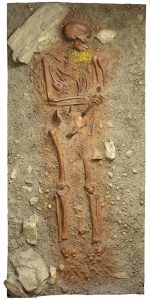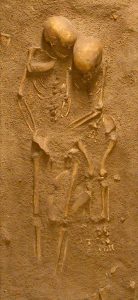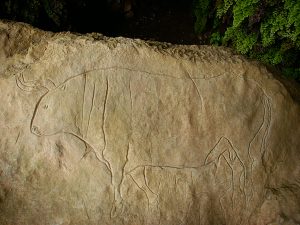The First Guardians of Memory. Burials in the Paleolithic
A fascinating exploration of the relationship between humans and death, from the earliest Neanderthal burials to the end of the Paleolithic.

Curated by Giacomo Giacobini, Cristina Cilli, and Giancarla Malerba
Venue: Sala Principe d’Acaja, Palazzo del Rettorato, via Verdi 8 / via Po 17, Turin
Free admission (Monday to Saturday, 10 AM – 6 PM)
The exhibition, presented by the University of Turin, with the University Museum System and Unita in collaboration with UniVerso, takes visitors on a journey through millennia by analyzing funeral rites, social evolution, and the first artistic expressions related to the cult of the dead, showcased through a series of casts of prehistoric burials.

Burial of the Young Prince, found in the Arene Candide Cave (Finale Ligure, Savona), dated to approx. 23,000 years ago
Funeral practices offer the opportunity to explore the deepest elements of human thought, since death rituals are not tied to material necessities but to different concerns, relating to the fate of an individual—or their body—after death. For this reason, they mark an important stage in human social history and provide insights into the story of the deceased and their social group.

Double burial from the Riparo del Romito (Papasidero, Cosenza), dated to approx. 10,000 years ago.
Thanks to Paleolithic burials—which preserved human remains from destruction by external factors—nearly complete skeletons have reached us, and their casts capture their condition at the very moment of discovery. A cast made during excavation is not a simple replica but a reproduction of a discovery context that no longer exists, thus becoming a testimony of extraordinary importance.

Boulder from the Riparo del Romito (Papasidero, Cosenza)
with engraving of an aurochs (Bos primigenius), placed near the double burial.
The Turin collection of prehistoric burial casts—partly made in Turin and partly obtained from other laboratories—is the most important of its kind internationally. This exhibition also marks the first step toward the creation of a Museum of Human Evolution, which will be located in the Palazzo degli Istituti Anatomici.
Are you a teacher? You can visit the exhibition independently with your class (free admission). Download the panel texts and captions of the displayed casts here.












